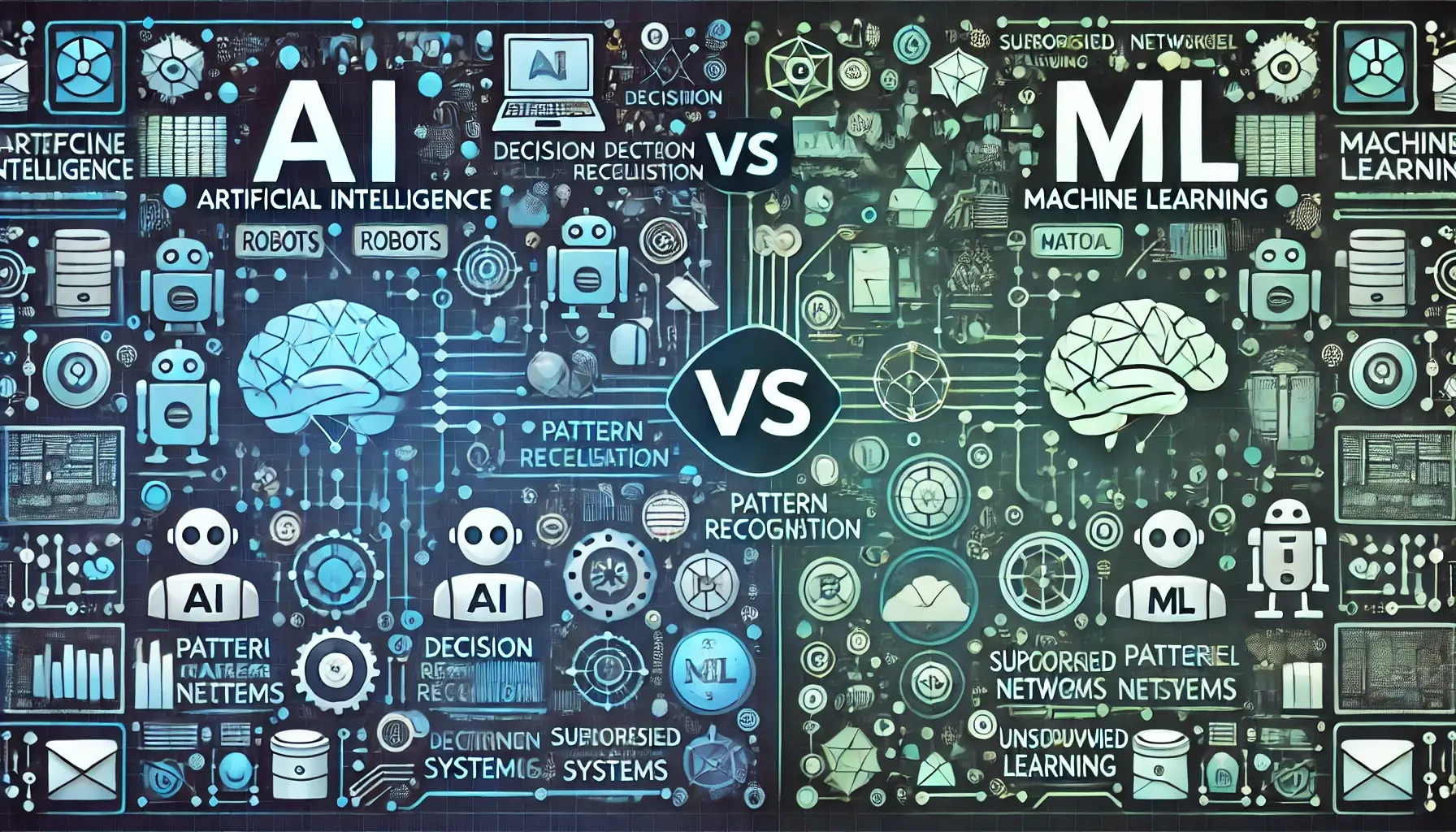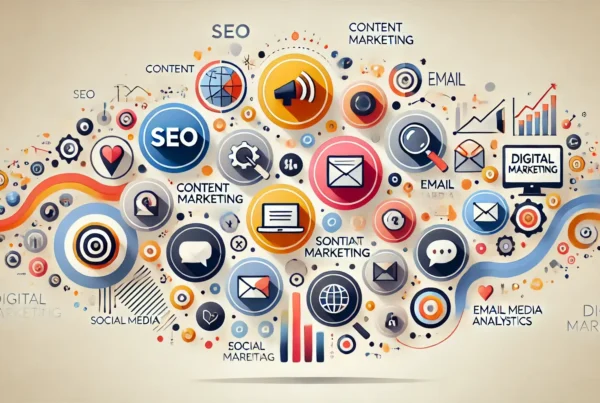Artificial Intelligence (AI) and Machine Learning (ML) are two terms that often get used interchangeably, but they represent different concepts within the realm of advanced computing. As AI technology continues to evolve and influence industries worldwide, understanding the distinctions between AI and ML has become more critical. In this article, we’ll explore these two technologies in depth, examining their definitions, differences, applications, and how they are reshaping the world.
What is Artificial Intelligence (AI)?
Artificial Intelligence (AI) refers to the broader concept of machines being able to carry out tasks in a way that we would consider “smart.” AI is about creating machines that can simulate human intelligence—performing tasks like decision-making, problem-solving, understanding language, recognizing patterns, and more.
The goal of AI is to build systems capable of mimicking human cognitive functions such as reasoning, learning, and adaptation. The term AI encompasses a wide range of applications, from basic automation to highly sophisticated systems that can learn from data and make decisions.
Types of AI
- Narrow AI (Weak AI): Narrow AI refers to systems designed to handle specific tasks or problems. Examples include virtual assistants like Siri and Alexa, recommendation systems used by Netflix or Amazon, and facial recognition software. Narrow AI operates under predefined constraints and does not possess the general intelligence of a human being.
- General AI (Strong AI): General AI is a theoretical concept of machines possessing the ability to perform any intellectual task that a human can do. Strong AI would have generalized cognitive abilities, allowing it to learn from experience and apply its knowledge across a broad range of situations. This level of AI remains in the realm of science fiction for now.
- Superintelligence: This is a step beyond general AI, where machines surpass human intelligence across all fields, from creativity to social intelligence. While often explored in movies and futuristic discussions, superintelligence raises significant ethical and philosophical questions and is not yet a practical reality.
AI Techniques
AI utilizes several techniques to simulate intelligence, including:
- Rule-Based Systems: Early AI systems used predefined sets of rules to perform tasks. These systems were limited in scope as they could only operate within the boundaries of their programming.
- Heuristic Search: AI often uses search algorithms to explore possible solutions to problems. Chess engines, for example, calculate possible moves and outcomes before making a decision.
- Neural Networks: Inspired by the human brain, artificial neural networks consist of layers of interconnected nodes. These networks process inputs, detect patterns, and make decisions or predictions.
What is Machine Learning (ML)?
Machine Learning (ML) is a subset of AI that focuses on the idea that machines can learn from data without being explicitly programmed to perform certain tasks. ML enables computers to adapt to new data and improve their performance over time, much like humans learn from experience.
Instead of being told step-by-step how to solve a problem, ML algorithms are designed to identify patterns and insights from data. By feeding vast amounts of data into an ML model, the system can “train” itself to make predictions or decisions without human intervention.
Types of Machine Learning
- Supervised Learning: In supervised learning, the model is trained on labeled data, where both the input and the output are known. The model makes predictions and adjusts itself based on the errors it makes. This method is used for tasks like classification (e.g., determining if an email is spam or not) and regression (e.g., predicting house prices).
- Unsupervised Learning: In unsupervised learning, the model is trained on data without explicit labels or outcomes. The goal is to find hidden patterns or intrinsic structures within the data. Clustering algorithms, such as k-means, are a common approach in unsupervised learning.
- Reinforcement Learning: In reinforcement learning, the model learns through trial and error. It receives rewards or penalties based on the actions it takes and adjusts its strategy to maximize the cumulative reward. This approach is often used in robotics, game AI, and autonomous systems.
- Semi-Supervised Learning: Semi-supervised learning sits between supervised and unsupervised learning. It uses a small amount of labeled data and a large amount of unlabeled data. This approach can improve learning efficiency by leveraging both types of data.
- Deep Learning: Deep learning, a subset of ML, refers to models based on deep neural networks, which contain multiple layers of interconnected nodes. Deep learning is behind many cutting-edge advancements in AI, such as image recognition, natural language processing (NLP), and autonomous driving.
Key Concepts in Machine Learning
- Algorithms: These are the core of ML models. Popular algorithms include decision trees, support vector machines (SVM), k-nearest neighbors (k-NN), and neural networks.
- Training Data: The data used to train ML models. The quality and quantity of the training data significantly affect the model’s performance.
- Features: These are individual measurable properties or characteristics of the data. Feature selection and engineering are critical for building robust ML models.
- Model Evaluation: After training, the model’s accuracy is evaluated using a separate set of data called the test set. Common evaluation metrics include accuracy, precision, recall, and F1-score.
AI vs. Machine Learning: The Differences
Now that we’ve explored the basics of AI and ML, it’s important to understand how they differ. AI is the broader concept of machines being able to carry out tasks in a way that would be considered intelligent, while ML is a specific application of AI that enables machines to learn from data.
1. Scope and Definition
- AI: Encompasses the entire field of simulating human intelligence through machines. AI includes any machine that can carry out tasks that normally require human intelligence, whether or not it involves learning.
- ML: A subset of AI that focuses specifically on the ability of machines to learn from data and make decisions without being explicitly programmed.
2. Approach
- AI: Can include rule-based systems, logic-based reasoning, and traditional programming methods. AI focuses on creating systems that can simulate human reasoning and decision-making.
- ML: Relies on algorithms and statistical models to enable machines to learn from data. ML is concerned with finding patterns in data and improving over time through training.
3. Goal
- AI: Aims to create machines capable of performing any intellectual task a human can do. AI seeks to simulate human thought processes to create intelligent systems.
- ML: Focuses on the ability to make predictions or decisions based on data. The goal of ML is to improve accuracy and performance through learning.
4. Examples
- AI: AI includes a wide range of technologies, such as robotics, natural language processing, speech recognition, and expert systems.
- ML: Machine learning applications include recommendation engines, fraud detection, image and speech recognition, and personalized marketing.
5. Data Dependency
- AI: AI can function with or without large datasets. For example, expert systems use predefined rules and logic to make decisions without needing to learn from data.
- ML: Machine learning heavily depends on large datasets to train models. The more data a machine learning algorithm has, the better it can learn and make accurate predictions.
6. Human Intervention
- AI: AI systems can be rule-based and require manual coding and intervention to improve or adjust their behavior.
- ML: ML systems require less human intervention after the initial setup. The models learn from data autonomously and improve over time with minimal supervision.
Applications of AI and ML
Both AI and ML have found their way into many industries and continue to revolutionize how businesses operate. Here are some key applications of both:
AI Applications
- Healthcare: AI systems are used for diagnosing diseases, predicting patient outcomes, and even performing robotic surgeries. AI-based virtual assistants also help in patient monitoring.
- Finance: AI is used in fraud detection, investment analysis, and automating trading processes. AI algorithms analyze massive datasets to make informed decisions in the financial market.
- Autonomous Systems: Self-driving cars, drones, and other autonomous machines rely on AI to make real-time decisions without human intervention.
- Robotics: AI-powered robots are used in manufacturing, warehousing, and logistics to improve efficiency and accuracy.
ML Applications
- Recommendation Systems: ML powers recommendation engines used by companies like Netflix, Spotify, and Amazon. These systems analyze user behavior to suggest movies, songs, or products.
- Image and Speech Recognition: ML models are widely used in facial recognition software, security systems, and voice-activated assistants like Siri and Google Assistant.
- Fraud Detection: Banks and financial institutions use ML to detect fraudulent transactions and prevent financial crimes by analyzing patterns in transaction data.
- Personalized Marketing: ML algorithms help companies create personalized marketing campaigns by analyzing user preferences and behaviors.
Conclusion
While artificial intelligence and machine learning are closely related, they represent different ideas. AI is the overarching concept of creating machines capable of intelligent behavior, whereas machine learning is one approach to achieving this goal by allowing systems to learn from data.
As AI and ML continue to advance, their impact on industries such as healthcare, finance, retail, and autonomous systems will only grow. By understanding the distinctions between these technologies, we can better appreciate how they complement each other in driving the future of innovation.




